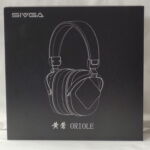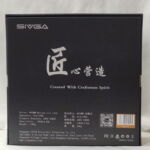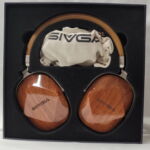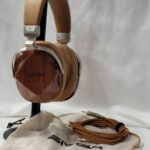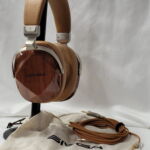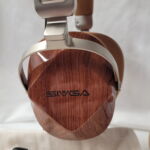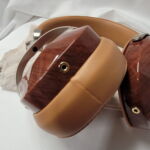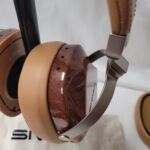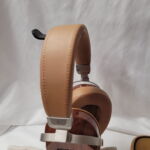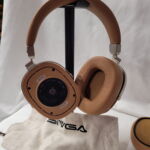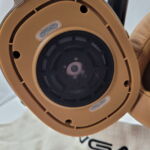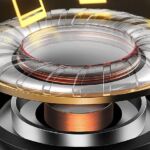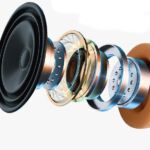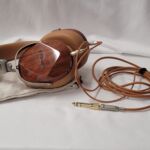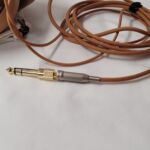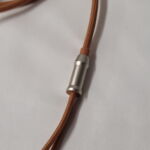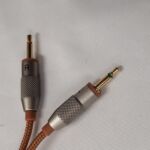Sivga Oriole
disclaimer: The Sivga Oriole was sent to me directly by Sivga for review. Sivga and its sibling Sendy Audio are making in-roads into the US market and are carried by Audio46 and Musicteck in the US as well as being available for order directly from the Sivga website worldwide. I have no financial interest in Sivga, Sendy, or any of their distributors, nor have I received any compensation for this review. Be sure to follow them on Facebook if you haven’t already so you get the next generation of product announcements.
Unboxing / Packaging:
The Oriole comes in a black lift top box with a silver line drawing of the headphones on the front and the specs and company info on rear. Lifting the lid reveals the headphones in a foam surround with the cable, carry bag, and 6.35mm adapter housed in a separate compartment in the foam to keep the headphones from getting scratched in transit. The bag is a linen like material but is thin enough that it may not protect the headphones well during travels. The cable is cloth wrapped and uses 2.5mm connectors at the northern ends and a 3.5mm single ended connector at the southern end.
Build/Fit:
I don’t normally reference other reviews when discussing a headphones build but with the Oriole being a direct descendant of the Robin, and so closely related that the two models are numbered SV021 and SV022 respectively I feel it makes sense to compare the two. The headband and cable remain unchanged but the cups, pads, and gimbals are all updated significantly. The stamped metal gimbals that only allowed rotation on the horizontal axis on the Oriole have been replaced by a new design that is machined instead of stamped and allow for 180° rotation on the vertical axis while retaining the same amount of rotation on the horizontal. This makes fit easier than its predecessor. Cups are larger and more square so they don’t look quite as svelte as the earlier model but the pads are more spacious and don’t touch the ear. The outer surface of the cups is diamond shaped and both stylish and functional.
Internals:
The Oriole uses a 50mm dynamic driver using a polycarbonate film diaphragm and in-house designed magnetic structure using Nd-Fe-B alloy to improve magnetic flux. The voice coil is copper clad aluminum wire further helping improve driver speed. Nominal impedance is listed as 32Ω with a sensitivity of 108dB/mW which makes the Oriole fairly easy to drive well from a variety of sources from dongles to DAPs to desktop gear. I found the Oriole paired well with the Burson Swing/Funk combo so used it for most of my listening tests.
Cable:
The Oriole’s cable remains unchanged from its parent the Oriole. It uses a single crystal copper wire with a cloth wrap in either black or tan depending on the headphone colorway. The Jack is 3.5mm straight with a knurled metal housing and a spring strain relief. The splitter and upper jack housings are matched metal barrel styles. The jacks at the top are 2.5mm mono style and the housings are well marked for easy indexing.
Sound:
Bass:
Sivga categorizes the Oriole as a balanced bass neutral headphone and listening bears out the bass being un-emphasized and very similar to its predecessor in that bass depth is good and there is some rumble when called for, but it isn’t going to make the bass hungry crowd happy with its more balanced presentation. Sub-bass extends well, but may go unnoticed unless a track particularly emphasizes it with more of the focus on mid-bass. Mid-bass has some slam but is more aligned with accuracy and definition than overall quantity. Decay is just a touch slow which allows notes to linger a bit and gives the mid-bass a natural tone without adding a lot of weight or warmth to the mix.
Mids:
Lower-mids have good clarity and vocals are well presented without sounding pushed or forced. There is a little less note weight in this region and it is noticeable in cello and sometimes in guitar tracks. This continues into the true mids where there is good detail and transparency but at the expense of notes sounding a bit thin. Piano parts are a good way to hear this thinning that I am referencing as they lack a bit of heft and don’t linger naturally in the ear. Violins have good energy and the weighting seems to impact them less as tonality is quite good. Higher voices in the upper-mids do take a step forward in the mix and will position in front of the lower voices as a result. The result is a mid that sounds overall a touch forward with good life but a bit less weight than its older sibling which was a touch recessed but a bit thicker in tone.
Treble:
This is where the Oriole really sings compared to the Robin. The lower-treble has good energy but doesn’t get strident or have the propensity to be fatiguing that the Robin did and above that drops back mildly so while retaining good energy, its a bit more polite listen. Overall the treble tuning gives the Oriole a mildly bright tonality but one that doesn’t venture into harsh waters in the process. Snare rattle has crisp edges, and cymbals have good energy without getting tizzy. There is some air and sparkle at the top, but not quite what we heard with the Robin. Overall the treble on the Oriole sounds equally well detailed and nuanced compared to its earlier sibling, but a bit more polite and refined.
Soundstage / Imaging:
Stage is deeper than wide by a good bit with some height but this is one place where the Robin outsings the Oriole as the stage is more intimate and a bit less well proportioned here than it was on its older sibling. Still seating the orchestra is straight forward if the result is a bit narrower and deeper than in reality. Instrument separation is still quite good and imaging is good within the limits of the stage with left to right feeling a bit narrow compared to the Robin. Movement around the stage is easy to track and positions are well defined. I did find some mild compression as tracks got faster but nothing that became muddy or obstructive.
Thoughts / Conclusion:
I found the Robin to be quite good when I reviewed it not long ago, and I find the Oriole a compelling follow-up. The mids are more present, a bit better highs, better build, and increased comfort all make the Oriole an easy upgrade from the Robin. Yes, the Oriole does command an additional $50 as currently on Amazon the Oriole runs $199, but it is money well spent in my estimation, particularly if you wear glasses (the vertical axis rotation of the Oriole vs the fixed Robin) or are in the slightest treble sensitive (better refinement above 2kHz). The Robin was already quite good for the asking price and the Oriole went a long way toward correcting what few gripes could reasonably be leveled at its predecessor. It’s nice to see a company that is actively listening to the feedback being given and taking direct action to improve the next product based on those suggestions. Sivga is miles ahead of many competitors in this respect. I sat thinking through what other models at $199 were worthy competitors to the Oriole and I’m having trouble finding one that checks all the boxes. The Drop/Senn products might compete on sound but not on build, same for Hifiman’s Rx series that feel a bit plastic fantastic. Truth is, its hard to find this kind of build quality and sound quality in the market without spending a good bit more than the asking price of the Oriole. Sivga done good with this one, you should definitely give it a try.
-
Bass - 7/107/10
-
Mids - 7.5/107.5/10
-
Treble - 7/107/10
-
Soundstage - 7/107/10
-
Imaging - 7/107/10
Summary
Pros: Great build, balanced signature with good mids
Cons: sparse kit, wont please bass-heads


